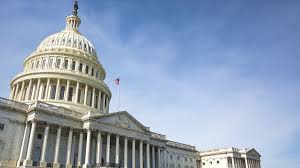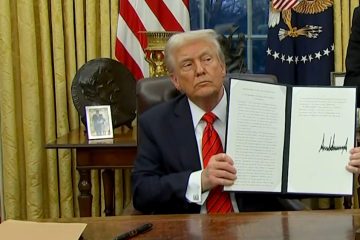America’s Budget Deficit Is Going to Top $1 Trillion Two Years Earlier Than Expected

The U.S. budget deficit is set to widen to $ 1 trillion by fiscal year 2020, two years sooner than previously estimated, according to the Congressional Budget Office.
The deficit will expand faster than thought after recent legislation that raised spending levels, according to the the non-partisan group’s annual budget outlook released Wednesday. That effect was somewhat moderated by the expectation of lower interest rates, which reduces borrowing costs.
It would be the first time the deficit exceeded the $ 1 trillion mark since 2012, as the economy recovered from the financial crisis. The deficit breaching that threshold would come as President Donald Trump runs for re-election.
Expanding Economy
Economic growth will expand at a 2.3% pace in the fourth quarter this year, followed by 2.1% next year, up from the agency’s prior estimate of 1.7%. After that, growth will slow to about 1.8% through to 2029, the CBO said.
“Partially offsetting the budgetary effects of new legislation are revisions to our economic forecast, which pushed down deficit projections,” said CBO Director Phillip Swagel in a statement.
Economists are increasingly warning that a recession may be on the horizon, with a key segment of the yield curve briefly inverting last week in what’s historically presaged a recession. The odds of a U.S. downturn in the next 12 months rose to 35% in Bloomberg’s August survey of economists, from 31% forecast previously.
Debt Strains
The growing U.S. debt load could add to strains on the economy, now in its longest expansion on record. It’s a troubling factor amid Trump’s ongoing trade war with China that’s delaying some investment, an increasingly gloomy consumer, and slowing global growth.
“The nation’s fiscal outlook is challenging,” Swagel said in the statement. “Federal debt, which is already high by historical standards, is on an unsustainable course, projected to rise even higher after 2029 because of the aging of the population, growth in per capita spending on health care, and rising interest costs.”
$ 1 Trillion Deficit
The budget deficit will widen to $ 1.01 trillion over the 12 months through 2020, from an expected $ 960 billion this year. The CBO said in January that the shortfall would come in around $ 890 billion next year and wouldn’t top $ 1 trillion until fiscal 2022.
As a share of GDP, the deficit is forecast to increase to 4.6% next year from 4.5% this year.
The deficit has expanded under Trump, amid the Republican‘s $ 1.5 trillion tax cut package, increased federal spending and an aging population that’s boosting the cost of social programs like Medicare. Trump said recently “a lot of people” would like a cut in payroll taxes and he’s floated the idea of a capital gains tax break, as his administration examines ways to juice the economy.
The U.S. last ran a deficit bigger than $ 1 trillion between 2009 and 2012, when former President Barack Obama ran a large bailout for the financial markets and a stimulus plan to yank the country out of the financial crisis.
More must-read stories from Fortune:
—This recession indicator is going off—but don’t use it to time the market
—The death of trading: More big banks think the business is a losing bet
—Business confidence is plummeting because of a “chaotic” environment
—How are big banks doing when it comes to diversity? Congress isn’t impressed
—“Negative” interest rates used to be unthinkable in the U.S.—not anymore
Don’t miss the daily Term Sheet, Fortune‘s newsletter on deals and dealmakers.







